Sony Cyber-shot DSC-W310
-
-
Written by Gordon Laing
Intro
One of eight W-series Cyber-shots released in January 2010, the Sony Cyber-shot DSC-W310 is a 12 Megapixel model with a 4x optical zoom and 2.7in screen. While most of the new W-series Cyber-shots are 14 Megapixel models, the W310 is an entry-level model which, though it lacks many of the sophisticated features of its more expensive W-series siblings, is positioned to compete on price with similarly specified best selling compacts from other manufacturers – these include the Nikon COOLPIX S3000 and the Canon IXUS 105 / SD1300 IS which we’ve compared it to here.
The Cyber-shot DSC-W310 falls firmly into the point-and-shoot category, providing some control over shooting settings like white balance, metering mode and ISO sensitivity. It includes consumer-friendly features like scene recognition, face detection and smile shutter, but doesn’t provide optical image stabilisation, opting instead for Sony’s SteadyShot blur reduction image processing.
The W310 can shoot 640 x 480 pixel VGA resolution video at 30 frames per second and has a dedicated movie mode switch making it ideal if you’re looking for a compact that’s equally at home shooting movies as stills. Like most new Sony compacts, as well as Sony’s proprietary Memory Stick Duo and Memory Stick Pro Duo media, the W310 will also accept SD and SDHC cards.
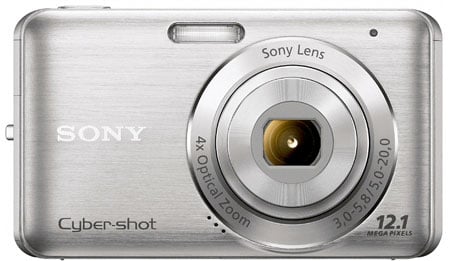 |
Bucking the trend for offering compacts in every colour of the rainbow, the Cyber-shot DSC-W310 is available in silver, black or pink. It’s quite a masculine no-nonsense looking design (even the pink one) and feels solidly put together. At 95 x 55 x 19mm it’s easily pocketable and of almost exactly the same dimensions as the Nikon COOLPIX S3000 and Canon IXUS 105 / SD1300 IS.
In your hands the W310 feels comfortable and secure. Though there isn’t a dedicated thumb rest, the layout of the controls on the rear panel provides a natural place for your thumb below the zoom rocker and the movie/still mode switch prevents your thumb sliding off the back. On the front of the camera, the cross-hatched Sony logo provides a natural resting place for your fingers.
 |
Though we prefer big unambiguous shutter buttons, the W310’s lozenge-shaped shutter release sits proud of the top panel and there’s no mistaking it for anything else. In fact the only other control here is the flush-mounted on/off button.
On the rear panel the four-way control pad has one-touch buttons that are configured slightly differently from the norm. There’s no exposure compensation button, you have to go to a menu for that, and the macro focusing button is likewise conspicuous by its absence – the W310 automatically focusses down to 5cm without needing to specifically select macro focusing. So the Flash and Self timer buttons are joined by a smile shutter button which can be used to quickly activate the smile shutter and a DISP button which alters the display brightness and toggles the info overlay.
|
At the top right edge of the rear panel you’ll find a switch that toggles the camera between still image and movie recording. It’s a small detail, but a significant one if you like to be able to switch recording modes in an instant, rather than having to navigate your way through a menu by which time you may have lost the moment.
Above the control pad is a small round button for switching to playback mode. Pressing this when the camera is turned off switches it on in playback mode without extending the lens, a useful function which the Canon IXUS 105 / SD1300 IS and Nikon COOLPIX S3000 also provide. At the bottom of the rear panel are two further buttons for accessing the menu system and deleting images.
The tripod bush is centrally located on the bottom panel and to the right of it is a slide and pop door which reveals the battery and card compartment. Like most recent Sony compacts, the W310 accepts SD and SDHC cards in addition to Sony’s proprietary Memory Stick Duo and Memory Stick Pro Duo formats.
While some recent Sony compacts have employed a proprietary port connector in the base of the camera, the W310 has a combined USB/AV port located under a flap on the right side of the body. Two cables are supplied – a standard USB cable for transferring images to your computer and an A/V cable with composite video and mono audio RCA phono connectors for connection to a TV. As with SD cards, Sony’s more recent selection of standard components over its proprietary formats is good news for consumers – if you ever lose these cables they’re relatively inexpensive and easy to replace.
The Cyber-shot DSC-W310 has a built-in flash unit with a quoted maximum distance of 3 metres at the wide angle lens setting. It tended to underexpose, or, to put it another way, under-illuminate subjects more than a metre or so from the camera and its illumination dropped of noticeably at the corners of the frame. It was pretty quick to recharge though – the orange charging indicator next to the flash symbol in the LCD panel flashed only momentarily between shots and was ready to go again in around three seconds.
In auto mode the flash fires when there’s insufficient natural lighting. In supported modes you can force it to fire or turn it off and there’s also a slow synchro mode. The Cyber-shot DSC-W310 has no AF assist lamp to bring in to use as a red-eye prevention mechanism as on the Canon IXUS 105 / SD1300 IS. It does, however, have a physical red-eye reduction system which when activated fires a pre-flash to contract your subject’s pupils and reduce the potential for the retinal reflections that cause the problem. There’s also a software red-eye correction filter which can be applied at the time of shooting or after you’ve taken the shot.
On a full charge, the Cyber-shot W310’s NP-BN1 rechargeable Lithium Ion battery provides enough power for 220 shots using the CIPA (Camera Imaging Products Association) standard. That’s exactly the same as the Nikon COOLPIX S3000 and slightly fewer than the Canon IXUS 105 / SD1300 IS. It’s not an Info-Lithium battery, so there’s a four-segment power remaining indicator, rather than a readout of the exact time remaining. The battery is charged outside the camera in the supplied AC charger.
Sony Cyber-shot W310 coverage wide | Sony Cyber-shot W310 coverage tele | |
 |  | |
| 5-20mm at 5mm (28mm equivalent) | 5-20mm at 20mm (112mm equivalent) |
The Cyber-shot DSC-W310 is equipped with a 4x optical zoom lens with an equivalent range of 28-112mm. That’s exactly the same as the Canon IXUS 105 / SD1300 IS. Though marginally different at 27-108mm, the NIKON COOLPIX S3000’s lens range is for all practical purposes the same. This is pretty much the perfect coverage for a 4x optical zoom, providing good wide-angle performance with a telephoto that’s ideal for close framing and portraiture.
When you switch the camera on the lens extends and is ready for action in a little over two seconds. Unlike the zoom collar surrounding the shutter release on the COOLPIX S3000 and IXUS 105 / SD1300 IS, the Cyber-shot has a thumb-operated zoom rocker at the top of the rear panel. This powers the zoom through its full range in a swift second or so. Like the COOLPIX S3000, the W310 has a tendency for the focus to slide way out during zooming (particularly from tele to wide and it takes fraction of a second for it to be corrected when you stop. We managed to nudge the W310’s lens through 10 discrete steps by prodding the rocker, which is a good level of control given how fast it moves when you keep it depressed.
The W310 has two digital zoom modes – Smart Zoom and Precision Zoom. Smart Zoom only works at resolution below the maximum and effectively takes a higher resolution shot and crops it. The zoom factor is dependent on the difference between the full and chosen image size. Precision zoom works in the conventional manner, by cropping the image and resampling using interpolation. Precision Zoom is limited to 2x, which at least avoids the abysmal quality results produced by digital zooms with higher ‘magnification’ factors.
Sony Cyber-shot DSC-W310 SteadyShot: off / Automatic | ||
 |  | |
100% crop, 5-20mm at 20mm, 1/20, 200 ISO, Program mode, SteadyShot off. | 100% crop, 5-20mm at 20mm, 1/20, 200 ISO, Program mode, SteadyShot auto. | |
Sony’s implementation and naming of its image stabilisation technologies has led to a degree of confusion among consumers who take an interest in such things. There are three variants – SteadyShot, Super SteadyShot and Optical SteadyShot; and to further complicate matters there’s also Active SteadyShot for movie recording. The W310 is equipped with SteadyShot image stabilisation which, Like Electronic VR on the Nikon COOLPIX S3000, post-processes images to digitally reduce motion blur caused by camera movement.
The crops above are taken from images shot with the Cyber-shot DSC-W310 in Program mode with the zoom at it’s maximum telephoto setting. At a sensitivity setting of 200 ISO the exposure was 1/20th of a second at f5.8. For the image on the left SteadyShot was set to off and for the one on the right it was set to auto. As with the Nikon COOLPIX 3000, over several shots taken in the same conditions it’s difficult to say that Steadyshot consistently makes an improvement, in this instance, however, the shot taken with SteadyShot activated is a marked improvment on the one without. But it’s still no patch on a true optical or sensor-shift stabilisation system.
The Cyber-shot W310 has two general-purpose autofocus options as well as face detection. The latter can detect up to eight faces in the frame, prioritising focus on one of them. The W310 lacks the facility available on some Sony compacts to weight the face detection algorithm in favour of adult or child faces, but nonetheless it works very well and is particularly quick to detect and lock onto faces in good lighting conditions. Indoors and when the light starts to fade it becomes a little less sure of itself, but that’s a criticism that can be made of all such systems, regardless of manufacturer or model.
Sony was one of the first manufacturers to introduce the smile shutter feature, so perhaps it’s not surprising that the W310’s smile shutter is superior to the equivalent feature on the Canon IXUS 105 / SD1300 IS or the Nikon CIOOLPIX S3000. You can switch it on or off with a single press of the left button on the control disc and, on recognising a smile, it fires the shutter without a moment’s delay. It’s also configurable – you can set it to trip the shutter at one of three smile thresholds ranging from a Mona Lisa enigmatic twinkle to a full-on grin.
In the absence of faces, or when face detection is turned off, the W310 defaults to a nine-area autofocus system called Multi AF and in Program mode you can choose between this and Centre AF which uses a single central area of the screen to set the focus.
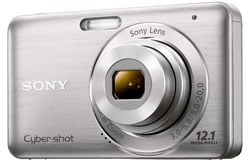 |
The W310 has a 2.7in screen with 230k pixels. This is the same specification as the screens on both the COOLPIX S3000 and IXUS 105 / SD1300 IS, but if ever there was a situation where the specification didn’t tell the whole story this is it.
When you look at the W310’s screen straight on, all is well, but tilt it more than 30 degrees vertically and the illumination drops off drastically. At more than 45 degrees you can’t see very much at all, which means if you’re holding the camera above your head you’ll be shooting almost blind. The view from either side is also less than optimal. The W310’s screen isn’t as bad as the COOLPIX S3000’s, but it falls a long way behind the Canon IXUS 105 / SD1300 IS and this is one area where a quality compromise is clearly evident in the lower priced camera. The LCD screen quality, of course, has no bearing whatsoever on the camera’s image quality, but it’s nice and useful to have one that’s bright and easily viewed from almost any angle. The display button on the control disc provides an option to increase the screen brightness and overlay exposure and other info, but this does nothing to improve its view ability at an angle.
The Cyber-shot W310’s menu system is activated by pressing the menu button on the rear panel. The top-level menu is arranged in a vertical strip down the left side of the screen and options appear on a ‘fly-out’ horizontal strip. It’s very similar to the arrangement of Canon’s Func.Set menu.
In record modes the menu configuration is dependent on the selected exposure mode, Program Auto providing access to all of the available options including image size, SteadyShot, continuous shooting, exposure compensation, ISO sensitivity, white balance, autofocus mode, metering mode smile detection sensitivity and face detection. As on most Sony compacts, the final menu icon is a toolbox which is used to access sound settings, power saving, digital zoom, date and time, card formatting and so on.
Generally, the menu system is easy to navigate and use and the fact that there are dedicated buttons for functions like movie shooting, display brightness and smile shutter means most people probably won’t have to access it all that often. But if you make frequent use of exposure settings like ISO sensitivity, white balance and exposure compensation you’ll find that they’re not quite as easy to get at as some compacts.
 | 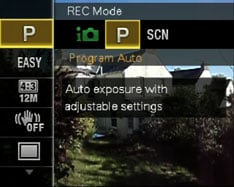 | 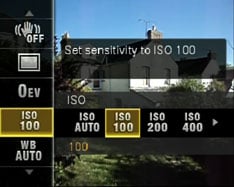 |
In playback mode there are resizing, red-eye correction, deletion, protection and printing options as well as a slideshow playback feature. This allows you to select a folder of images and set the playback interval, but you can’t choose transitions (it’s a straight cut) and the option to select a music backing available on some other Sony compacts is absent.
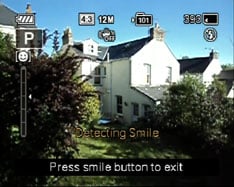 |  |  |
|
In Intelligent Auto mode the Cyber-shot W310 uses scene recognition to augment its exposure metering and choose appropriate exposure and focus settings for the subject. The camera chooses one of six scene modes – Twilight, Twilight portrait, Backlight, Backlight portrait, Landscape, Portrait and Macro.
When the camera has determined what kind of scene is before it an icon is displayed in the top left corner of the screen. The W310’s scene recognition is quick and accurate, but, like the COOLPIX S3000 it had a tendency to identify shots with lots of sky as backlit.
In Program mode the exposure is still set automatically but scene recognition is disabled. In its place you have access to all of the exposure and other settings described earlier including ISO sensitivity, white balance, exposure compensation and metering. There are three metering modes – Multi, which bases exposure on the entire frame, Centre and Spot.
The Cyber-shot W310 has eight scene modes – High Sensitivity, Soft snap, Landscape, Twilight portrait, Twilight, Gourmet, Beach and Snow. High sensitivity mode disables the flash and automatically boosts the ISO sensitivity to enable hand-held shots indoors and in low light. Soft Snap uses a wide aperture to blur the background and Twilight portrait uses the flash in slow synchro mode.
The W310 has fewer scene modes than either the Canon IXUS 105 / SD1300 or the Nikon COOLPIX S3000 and this makes it a less attractive option if you like to shoot in unusual conditions. Scene modes are also used on other models to provide additional functions.
For example the COOLPIX S3000 offers backlight, Fireworks show and panorama assist scene modes, while the IXUS 105 / SD 1300 has long shutter, Underwater (for which you’ll need the WP-DC36 underwater housing) and Face self-timer scene modes.
While we wouldn’t expect to see Sony’s composite exposure-based Anti motion Blur or Handheld Twilight modes on a model in this range, the Sweep Panorama feature would have been a welcome inclusion. For that you’ll need a higher-end model in the W range, like the W350.
The Cyber-shot W310 can shoot 640 x 480 pixel (VGA resolution) video at 30 frames per second and also has a QVGA 320 x 240 pixel option again at 30fps. Footage is saved using a Motion JPEG codec at an average bit rate of 9Mbps and saved with mono audio in an AVI wrapper.
As we’ve already mentioned, one thing that sets the Cyber-shot W310 apart from its close rivals is a dedicated button for switching between still and movie shooting. Another difference is the lack of any zoom while filming, whether optical or even digital.
As with all compacts that use a CCD sensor, there’s also a risk of smearing – coloured vertical bands – in video with extremely bright highlight details such as reflections on water or when shooting into the sun. Registered members of Vimeo can download our original clip here.
In Burst mode the Cyber-shot W310 can shoot 12 Megapixel images continuously at a consistent rate of 0.8 frames per second. If you reduce the resolution to 5 Megapixels you get a slightly improved rate of 1.1fps. Neither of these is fast enough to capture a fast action sports sequence, but a sequence of frames a second apart can be a good way to capture less rapid action. When in Burst mode the ISO sensitivity range is restricted to 800 ISO and below and, like most other compacts, the focus is fixed for the entire sequence once the shutter is pressed.
The Cyber-shot W310 has a 1/2.3in CCD sensor with a maximum image size of 12 Megapixels producing 4:3 shaped pictures with maximum dimensions of 4000 x 3000 pixels. There are three lower resolution 4:3 settings plus two cropped 16:9 options at 2 and 9 Megapixels. All images are saved as JPEGs with no control over the amount of compression. Interestingly, full resolution JPEG file sizes are remarkably consistent at around 4.25MB, suggesting that the amount of compression is varied in order to produce a consistent file size. It’s more usual to apply the same amount of compression, producing file sizes that vary depending on the compressibility of the image content. The ISO sensitivity ranges from 100 to 3200 ISO.






